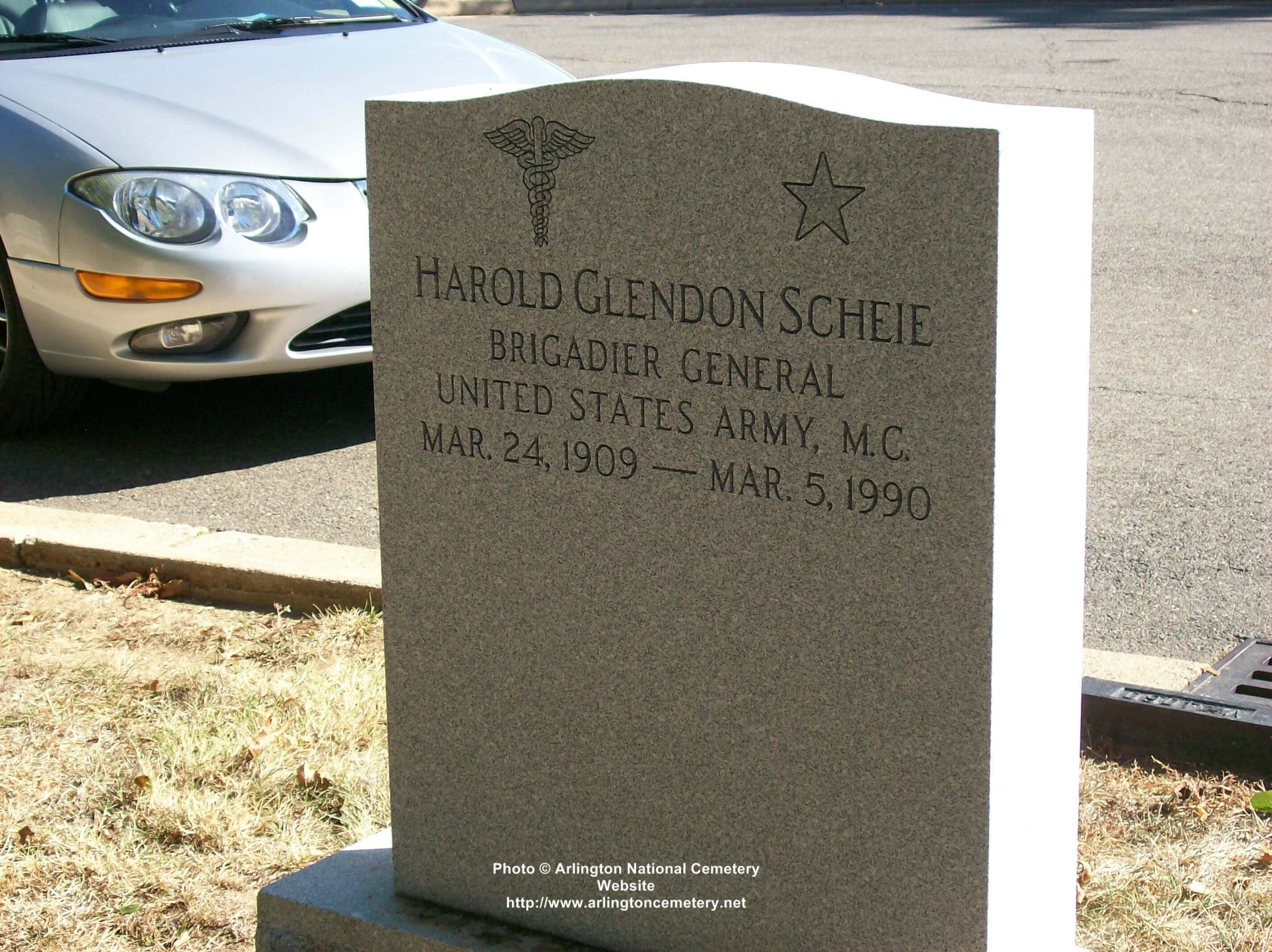Courtesy of the University of Pennsylvania:
Harold Scheie was born in Brookings County, South Dakota in 1909, the son of Lars T. Scheie and Ella Mae Ware Scheie. He was educated in the Warren, Minn., public school system, and in 1926 he graduated from Warren High School. He attended the University of Minnesota and received a B.S., 1931, and M.D., 1936. He completed his Internship, 1935-1937, and Residency, 1938-1940, at the Hospital of the University of Pennsylvania. In 1940, he received a D.Sc., from the University of Pennsylvania. Dr. Scheie secured a position as Instructor and then Associate Professor of Ophthalmology in the Medical School of the University of Pennsylvania, 1940-1942.
During World War II, he served, with the other staff members of the Medical School, at the 31st Hospital Unit of the Army Medical Corps, located on the Ledo Road in the China, Burma, India Theatre. Scheie treated many patients while serving in the Army; his most memorable patient, however, was Lord Louis Mountbatten of Burma. Mountbatten had injured his eye in a jeep accident. Scheie success in saving Mountbatten's eye resulted in a friendship that would last throughout their lives. Like his relationship with Mountbatten, Dr. Scheie's service in the Army would also continue well beyond the period of World War II. He belonged to many military organizations and continued to serve in the reserves until 1964 when he retired with the rank of Brigadier General.
After the war, he returned to the Department of Ophthalmology in the Medical School, University of Pennsylvania. He remained connected the University for the remainder of his professional life. He held the following positions: Assistant Professor, 1945-1949, Associate Professor, 1949-1953; Professor, 1953-1979; Department Chairman and the William F. Norris and George E. deSchweinitz Professor of Ophthalmology, 1960-1977, and Emeritus Professor, 1979-1983. In 1964, Dr. Scheie encouraged the University to merge with the Wills Eye Hospital. The University decided against his recommendation. As a result, Scheie began raising funds for an independently financed eye institute which would eventually become affiliated with Presbyterian Hospital. His fundraising efforts met with enormous success, and in 1972, the Scheie Eye Institute was dedicated. At this time the Department of Ophthalmology moved to the Scheie Eye Institute as a result of the University's affiliation with Presbyterian Hospital. From 1972 until 1977, Dr. Scheie served as the Founding Director of the Scheie Eye Institute. He retired from practice in 1983 devoting his time to fundraising for the Institute.
Remaining at the cutting edge of his profession, Scheie worked tirelessly at his research. Some of the topics covered by his research include: Adie's syndrome, retinal detachment, glaucoma surgery, infantile glaucoma, ocular injuries, Hurler's disease, herpes, cataracts and cataract extraction, hemophilia and the eyes, Rubella Syndrome, thyroid, Scheie Syndrome, and myopia. Throughout his career, Dr. Scheie wrote over 200 articles, the standard textbook on ophthalmology, and delivered countless lectures and speeches. He saw thousands of patients in his private practice limited to diseases of the eye, 1947-1987, and developed a technique for cataract removal which became widely used, and ultimately named for Scheie.From 1948 until 1989, he traveled extensively attending over 150 professional conferences, from Oklahoma City to China to Nairobi. He was actively involved in: the Academia Ophthalmologica Internationalis, the Academy of Ophthalmology and Otolaryngology, the Afro-Asian Congress of Ophthalmology, the American Academy of Ophthalmology and Otolaryngology, the American College of Surgeons, the American Medical Association, the American Ophthalmological Society, the American Society for Contemporary Ophthalmology, the College of Physicians, the International Academy of Ophthalmology, the Medical Association of South Africa, and the Pan-American Congress of Ophthalmology. In addition he served as an advisor to: the Governor's Committee on Diabetes, 1969-1975, Pennsylvania Working Home for the Blind, 1958-1959, Pennsylvania Association of the Blind, and a number of other societies for the blind or the prevention of blindness. Scheie's dedication did not go unnoticed. He was the recipient of many awards and honors. Some of which include: the American Medical Association's Gold Medal, 1962, the Irving S. Cutter Medal, 1968, the Pennsylvania Award for Excellence, 1970, Freedom's Foundation Award, 1972, Horatio Alger Award, 1974, Pennsylvania Academy of Ophthalmology Distinguished Achievement Award, 1974, the Strittmatter Award, 1976, the International Glaucoma Congress Gold Medal, 1977, the Saunders Award, 1978, the National Exhibit for Blind Artists Distinguished Achievement Award, 1983, the Howe Award, 1984, the Pop Warner Award, 1985, and the Shaffrey Award, 1989. He was also honored with honorary degrees from Villanova University, 1969, the University of Pennsylvania, 1978, and the University of Minnesota, 1989 and a Philadelphia City Council Resolution, 1982. Dr. Scheie's personal community interests were wide ranging. He was active in many clubs and organizations. He was a long time member of the Union League, the Merion Cricket Club, the Philadelphia Country Club, and the Republican Party. He participated regularly in the “Boggie Buster” celebrity golf tournament for multiple sclerosis, Variety Club and United World Colleges affairs, and attended charitable functions for many other causes. He was a faithful follower of the Philadelphia Phillies.
Michael Robert Patterson was born in Arlington and is the son of a former officer of the US Army. So it was no wonder that sooner or later his interests drew him to American history and especially to American military history. Many of his articles can be found on renowned portals like the New York Times, Washingtonpost or Wikipedia.
Reviewed by: Michael Howard

